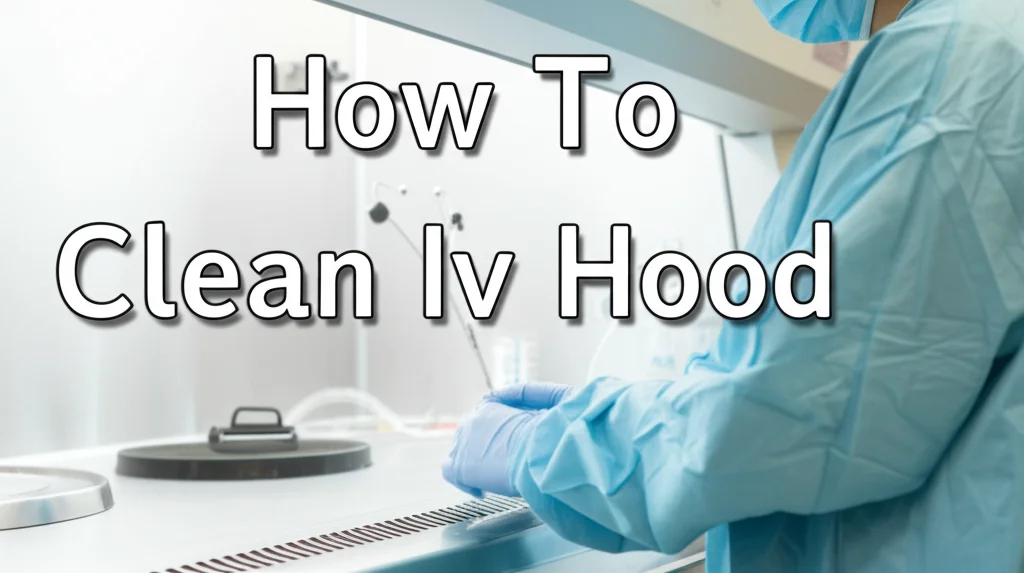· Healthcare Cleaning · 6 min read
How To Clean IV Hood

How to Clean an IV Hood: A Comprehensive Guide
Have you ever wondered how hospitals maintain the incredibly sterile environments needed for safe intravenous (IV) medication preparation? A crucial component is the proper cleaning of IV hoods, also known as laminar airflow hoods. These hoods protect medications from contamination, directly impacting patient health. This article will guide you through the process of how to clean an IV hood effectively, ensuring a safe and sterile workspace. We’ll cover everything from necessary supplies to a detailed step-by-step cleaning procedure, and best practices for maintaining a consistently clean hood.
Key Takeaways:
- Regular cleaning is vital for maintaining a sterile IV hood.
- Use only approved disinfectants and follow manufacturer instructions.
- Proper technique, including wiping patterns, is crucial to avoid recontamination.
- Documentation of cleaning is essential for quality control and compliance.
What is an IV Hood and Why is Cleaning Important?
An IV hood is a specialized ventilated enclosure designed to create a particle-free workspace for preparing sterile medications. It works by drawing air through a HEPA filter, which removes bacteria, viruses, and other contaminants. Maintaining this sterility is paramount because contaminated medications can lead to serious infections in patients. Regular and thorough cleaning of the IV hood is therefore not just a good practice, it’s a critical safety measure. Without consistent cleaning, the hood’s effectiveness is compromised, potentially putting patients at risk.
Gathering Your Supplies for IV Hood Cleaning
Before you begin, having the right supplies readily available will streamline the cleaning process. Don’t start until you have everything you need to avoid interruptions and potential contamination. Here’s a checklist of essential items:
- Approved Disinfectant: Crucially, use a disinfectant specifically approved for use in IV hoods. Isopropyl alcohol (70% or 90%) is commonly used, but always check your facility’s policy.
- Lint-Free Wipes: Regular paper towels can leave behind lint, which can contaminate the sterile field. Opt for wipes specifically designed for cleanroom environments.
- Clean Gloves: Wear sterile gloves throughout the entire cleaning process to prevent introducing contaminants from your hands.
- Spray Bottle: For applying the disinfectant. Ensure it’s clean and dedicated solely for this purpose.
- Timer: To ensure adequate contact time for the disinfectant to be effective.
- Cleaning Log: A record to document the date, time, and initials of the person performing the cleaning.
- Biohazard Waste Container: For disposing of used wipes and other contaminated materials.
Step-by-Step Guide to Cleaning Your IV Hood
Now that you have your supplies, let’s walk through the cleaning process. Following these steps carefully will help ensure a thorough and effective clean.
- Preparation: Put on clean gloves. Remove all medications, supplies, and any other items from the IV hood.
- Initial Wipe Down: Lightly spray the entire work surface of the IV hood with the approved disinfectant. Using a lint-free wipe, wipe down the surface in a circular motion, starting from the back and working your way forward.
- Side Walls: Spray the side walls of the hood with disinfectant. Wipe down in a top-to-bottom, overlapping pattern. This ensures complete coverage and prevents streaks.
- Interior Hood Surfaces: Pay attention to all interior surfaces, including the light fixture and any internal components. Spray and wipe each area thoroughly.
- Contact Time: Allow the disinfectant to remain on the surfaces for the manufacturer’s recommended contact time. This is crucial for killing bacteria and viruses. Typically, this is around 30 seconds to 10 minutes, depending on the disinfectant.
- Final Wipe Down: After the contact time has elapsed, use a fresh, lint-free wipe dampened with disinfectant to perform a final wipe down of all surfaces. This removes any remaining disinfectant residue.
- Documentation: Record the cleaning in the cleaning log, including the date, time, and your initials.
Understanding Wiping Techniques for Sterile Environments
The way you wipe down the IV hood is just as important as the disinfectant you use. Incorrect wiping techniques can actually spread contamination instead of removing it. Here’s what you need to know:
- Overlapping Strokes: Always use overlapping strokes when wiping. This ensures that no area is missed.
- Circular Motion: A circular motion is generally recommended for initial cleaning, but switch to a top-to-bottom pattern for final wiping.
- One Direction: Avoid wiping back and forth repeatedly over the same area. This can redistribute contaminants.
- Change Wipes Frequently: Use a fresh wipe whenever it becomes visibly soiled or saturated with disinfectant.
- Avoid Touching Clean Surfaces: Be mindful not to touch any clean surfaces with your gloved hands or used wipes.
Frequency of Cleaning: Daily, Routine, and Terminal
The frequency of IV hood cleaning depends on its usage and your facility’s policies. There are three main levels of cleaning:
- Daily Cleaning: This involves a quick wipe down of the work surface before and after each use. This helps prevent the buildup of contaminants.
- Routine Cleaning: A more thorough cleaning, as described in the step-by-step guide above, should be performed at least weekly, or more frequently if the hood is used heavily.
- Terminal Cleaning: This is a deep cleaning performed when the hood is undergoing maintenance, after a spill, or if contamination is suspected. It involves a complete disassembly and cleaning of all components.
Maintaining Airflow and Filter Integrity
Cleaning the surfaces of the IV hood is only one part of the equation. Maintaining proper airflow and filter integrity is equally important.
- Airflow Monitoring: Regularly check the airflow indicator to ensure the hood is functioning correctly. If the airflow is compromised, the hood should not be used.
- Filter Replacement: HEPA filters need to be replaced periodically, as recommended by the manufacturer. A clogged filter reduces airflow and compromises sterility.
- Annual Certification: IV hoods should undergo annual certification by a qualified technician to verify their performance and compliance with regulatory standards. This certification ensures the hood is functioning as intended and providing a sterile environment.
Frequently Asked Questions (FAQs)
- Can I use household cleaners to clean an IV hood? No. Household cleaners are not designed for sterile environments and may leave behind residues that can contaminate medications. Always use an approved disinfectant.
- How often should I change my gloves during cleaning? Change gloves if they become torn, soiled, or saturated with disinfectant.
- What should I do if I suspect the IV hood is contaminated? Immediately stop using the hood and notify your supervisor. A terminal cleaning should be performed.
- Is it necessary to document each cleaning? Yes. Documentation is essential for quality control, compliance, and tracking cleaning frequency.
- What is the best way to dispose of used wipes? Dispose of used wipes in a biohazard waste container.
- Can I use a steam cleaner to clean an IV hood? No, steam cleaners can introduce moisture and potentially damage the hood’s components.
Conclusion: Ensuring Patient Safety Through Proper IV Hood Cleaning
Cleaning an IV hood is a critical responsibility in any healthcare setting. By following the steps outlined in this guide, you can ensure a sterile environment for preparing medications, ultimately protecting your patients from potentially harmful infections. Remember to always use approved disinfectants, proper wiping techniques, and maintain a consistent cleaning schedule. Regular cleaning, combined with airflow monitoring and filter maintenance, will help you maintain a safe and effective IV hood for years to come. Prioritizing this task demonstrates a commitment to patient safety and quality healthcare.
- IV Hood Cleaning
- Sterile Environment
- Healthcare Sanitation




